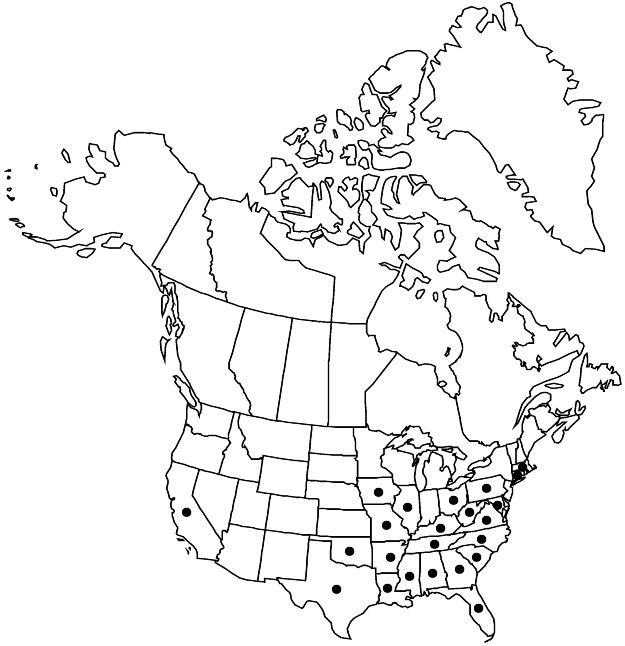Rosa lucieae
Bull. Soc. Roy. Bot. Belgique 10: 324. 1871. (as luciae)
Stems procumbent or climbing, 10+ dm, rooting at nodes; bark of canes green or brown; prickles infrastipular and/or internodal, single or paired, curved or declined, ± stout, 4–5 × 2 mm, aciculi absent. Leaves deciduous (north) or semipersistent (south), 8–10 cm; stipules narrowly lanceolate, 10–12 × 2–3 mm, auricles erect, sometimes flared, 2–4 mm, margins fimbriate, stipitate-glandular, surfaces glabrous, eglandular; petiole and rachis with pricklets, glabrous, stipitate- or, sometimes, sessile-glandular; leaflets 7–9, terminal: petiolule 5–9 mm, blade broadly ovate to obovate, 15–30 × 12–20 mm, leathery, base cuneate, margins 1(–2)-serrate, teeth 12–16 per side, acute, gland-tipped, apex acute to acuminate, abaxial surfaces glabrous, eglandular except for glands on midveins, adaxial green, lustrous, glabrous. Panicles (1–)5–20+-flowered. Pedicels 18–25 mm, glabrous, eglandular; bracts 1–3, lanceolate, 9–16 × 2.5–5 mm, margins sparsely stipitate-glandular, surfaces glabrous, eglandular. Flowers scent of apple or clover, 2–2.5 cm diam.; hypanthium urceolate, 4–6.5 × 2–3 mm, eglandular, neck (0–)1 × 4–5 mm; sepals ovate-acuminate, 6–8 × 1–1.5 mm, margins pinnatifid, tip 2 × 0.5 mm, abaxial surfaces glabrous, eglandular; petals double, sometimes single, white, pink to rose distally, 13–15 × 11–15 mm; carpels 12–21, styles pilose, exsert 3.5–5 mm beyond stylar orifice (1.5–2 mm diam.), hypanthial disc appearing flattened with age, 3–4 mm diam. Hips red, globose, 5–10 × 5–9 mm, eglandular. Achenes 1–11, dark tan, 4–4.5 × 2–2.5 mm. 2n = 14(28).
Phenology: Flowering Jun–Aug.
Habitat: Disturbed areas, roadsides, flood plains, old homesteads, dry woods, highway verges
Elevation: 0–500 m
Distribution

Introduced; Ala., Ark., Calif., Conn., Fla., Ga., Ill., Iowa, Ky., La., Md., Mass., Miss., Mo., N.C., Ohio, Okla., Pa., S.C., Tenn., Tex., Va., W.Va., Asia (China, Japan, Korea), introduced also in Mexico, Pacific Islands (New Zealand, Philippines).
Discussion
Introductions of Rosa lucieae in North America are largely from cultivars. The species is most common in southern and mid-latitudes of eastern and south-central United States. With spreading stems to 60 dm, R. lucieae is a typical stoloniferous plant forming carpets of colorful groundcover.
Rosa lucieae cultivars and hybrids have been widely used in breeding rambler and climbing roses. Its creeping stems extend to 60 dm and root readily, forming a white- or pink-petaled ground cover for gardens and cemeteries, and along highways where it also serves to stabilize verges. The most commonly found cultivar in North America is 'Dorothy Perkins'.
Selected References
None.